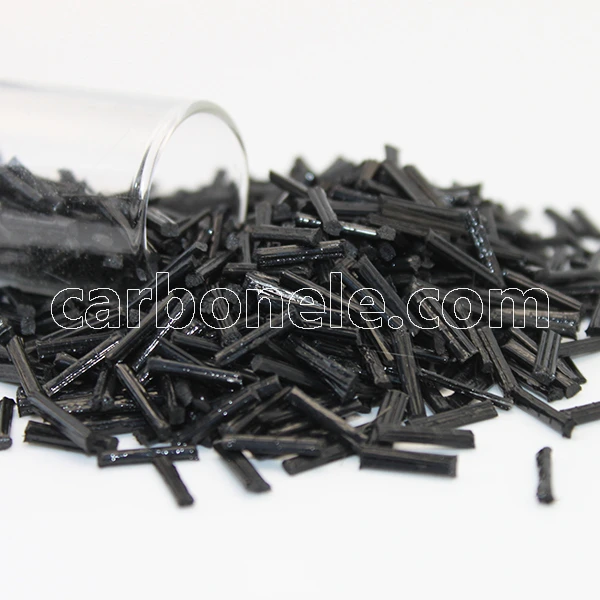
Nylon 12 LCF30-PA12 Polyamide 12 LCF30% Raw Materials
LCF30-PA12 Polyamide 12 LCF30% Raw Material has high strength, rigidity, abrasion resistance, is lightweight, chemically stable, thermally stable, impact – tough, processable and environment – friendly (recyclable).
- Model number: PA12-LCF-BCA3
- Reinforcing filler: Long carbon fiber
- Matrix resin: Polyamide 12
- Molding conditions: Injection/extrusion molding
- Samples: 3-25kgs
- Origin: Xiamen, China
- MOQ: Negotiable
LCF30-PA12 is a composite material with Nylon 12 (PA12) as the base matrix, reinforced with 30% long carbon fibers (LCF).
- PA12 Properties: Excellent abrasion resistance, high toughness, and chemical stability.
- LCF Benefits: Enhances tensile strength, rigidity, and impact resistance while maintaining lightweight properties.
Production Method
Manufactured via extrusion or injection molding:
- Mixing: Uniform dispersion of PA12 and LCF to prevent uneven fiber distribution.
- Melting & Molding: Heated to molten state for shaping, ensuring optimal fiber alignment.
Performance Advantages
- High Strength & Rigidity: Withstands heavy loads without deformation.
- Superior Abrasion Resistance: Ideal for high-wear applications (e.g., automotive parts).
- Lightweight: Reduces weight vs. metals, improving fuel efficiency (automotive/aerospace).
- Chemical & Thermal Stability: Resists acids, alkalis, and high temperatures.
- Impact Toughness: Maintains durability even at low temperatures.
- Processability: Suitable for complex shapes via extrusion/injection molding.
- Eco-Friendly: Recyclable via mechanical or chemical methods.
Applications
- Automotive: Body structures, engine components (20% lighter, 30% stronger).
- Aerospace: Interior parts, landing gear (weight-critical applications).
- Electronics: Device housings, circuit board supports.
- Sports Equipment: Bicycle frames, golf clubs (lightweight + durability).
Recycling
- Mechanical: Crushing into reusable pellets/powders.
- Chemical: Breaking down into raw materials for reprocessing.
Case Study
Automotive Body Parts (Carbon Xiamen):
- 20% weight reduction vs. metal, improving fuel efficiency.
- 30% higher strength, enhancing safety and durability.
- Lower maintenance costs due to superior wear resistance.
This composite offers an optimal balance of strength, weight, and sustainability, making it ideal for advanced engineering applications.
If you are interested in purchasing this composite material, please contact the manufacturer directly.
How to Get in Touch with Us?
You can obtain product specifications, performance, pricing, and other information to choose the right product based on your needs. Additionally, you can request samples from the manufacturer for testing to ensure the material meets your requirements.

Frequently Asked Questions
Carbon (Xiamen) New Material Co., Ltd. aims to provide buyers with "one-stop" worry-free high-quality services. Here you can find all information about carbon fiber engineering plastics. If you still have questions, please send us an email for consultation!
-
How can I contact the manufacturer of a product that interests me?
When you find a product you are interested in, you can contact the manufacturer directly by sending an email and we will get back to you as soon as possible.
-
How do I find the products that interest me?
All you need to do is enter the keyword, product name in the search window and press the Enter key on your keyboard. Your search results page will then be displayed. You can also search within the product category pages on the home page. Each category is divided into subcategories, allowing you to refine your search and find products that interest you.
-
Where will I find a buying guide?
Please contact our after-sales service directly and we will provide you with a comprehensive operating guide.
-
What are CF Reinforced Thermoplastic Composites?
CF Reinforced Thermoplastic Composites are materials where carbon fibers are incorporated into a thermoplastic matrix. They combine the strength and stiffness of carbon fibers with the processability and recyclability of thermoplastics. For instance, they are used in automotive parts like bumper beams.
-
What are the benefits of CF Reinforced Thermoplastic Composites over traditional composites?
The key benefits include faster production cycles, easier recyclability, and better impact resistance. They also offer design flexibility. An example is in the manufacturing of consumer electronics casings where complex shapes can be achieved more easily.
-
How are CF Reinforced Thermoplastic Composites processed?
Common processing methods include injection molding, extrusion, and compression molding. Injection molding is widely used for mass production. For example, in the production of small components for the medical industry.
-
What industries use CF Reinforced Thermoplastic Composites?
They are utilized in aerospace, automotive, medical, and sports equipment industries. In aerospace, they can be found in interior components. In the medical field, they might be used in prosthetics.
-
How does the carbon fiber content affect the properties of the composites?
Higher carbon fiber content generally leads to increased strength and stiffness but may reduce ductility. A moderate content is often balanced for specific applications. For example, a higher content might be preferred in structural parts of a race car.
-
What are the challenges in using CF Reinforced Thermoplastic Composites?
Challenges include higher material costs, complex processing equipment requirements, and ensuring uniform fiber dispersion. Issues with adhesion between the fibers and the matrix can also arise. An example is in achieving consistent quality in large-scale production.
























